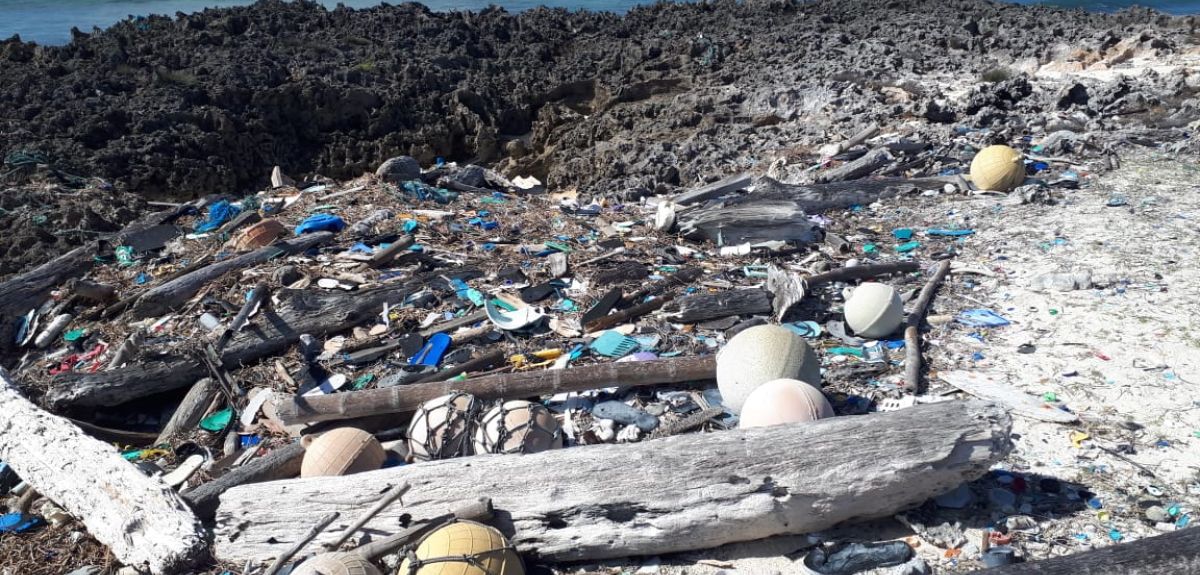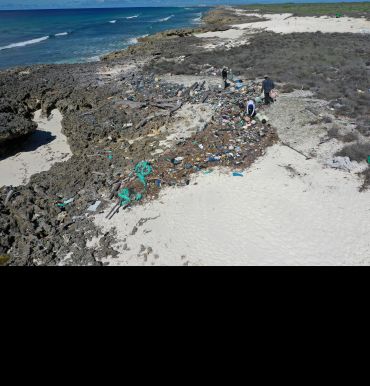
New study shows that most plastic debris on Seychelles beaches comes from far-off sources
A new study led by the University of Oxford has developed a high-resolution model to quantify the sources of plastic debris accumulating on beaches across the Seychelles and other island states in the western Indian Ocean. The results, published in Marine Pollution Bulletin, demonstrate that most of this waste originates from distant sources and not from the islands themselves.
The model simulated the movement of both land-based and marine types of plastic pollution across the world’s oceans. This used input data on ocean currents, waves, and winds, and plastic debris entering the ocean from coastal populations, rivers and fisheries, to predict plastic debris accumulation at 27 sites in the Seychelles and wider western Indian ocean.
 Plastic debris on Aldabra Atoll, a remote coral island and UNESCO World Heritage Site in the southwestern Seychelles, photographed as part of the Aldabra Clean-Up Project. Image credit: Seychelles Islands Foundation (SIF).
Plastic debris on Aldabra Atoll, a remote coral island and UNESCO World Heritage Site in the southwestern Seychelles, photographed as part of the Aldabra Clean-Up Project. Image credit: Seychelles Islands Foundation (SIF).
- Indonesia is the primary source of land-based plastic debris found on beaches in the Seychelles, with major contributions from India and Sri Lanka. This was particularly the case for medium-large debris that have a high buoyancy (such as bottle caps, sandals, bottles, and small domestic items).
- Plastic debris arriving from Indonesia would have been at sea for at least 6 months, with some exceeding 2 years.
- Smaller plastic debris, such as millimetre-sized plastic fragments and pellets, tended to originate from East Africa and from within the Seychelles itself. Smaller fragments are less buoyant than larger items, and do not travel as far before sinking.
- The Seychelles also accumulate significant amounts of plastic debris of marine origin from fisheries and shipping lanes, such as discarded or lost fishing gear. The large numbers of bottles beaching at these islands with labels suggesting they come from Malaysia, Thailand and, in particular, China, were probably discarded from ships rather than floating from those countries directly. For some islands, a significantly higher proportion of plastic waste comes from marine sources, rather than land.
- Rates of plastic debris accumulation showed a strong seasonal affect. Plastic debris from both land and marine sources was most likely to land on beaches in the Seychelles at the end of the northwest monsoon, with the highest rates in March and April.
- Plastic debris accumulation may also be amplified by El Niño–Southern Oscillation (ENSO) and Indian Ocean Dipole (IOD, also known as the Indian Niño) events.
This is the first study to produce a quantitative estimate of the sources of plastic debris for the Seychelles and other remote islands in the western Indian Ocean. Such plastic pollution is a significant environmental threat, both for marine ecosystems and the communities that depend on the ocean for food, tourism, and other economic activities. In addition, plastic debris that drifts from far-off sources increases the risk of spreading invasive species and diseases.
The study was motivated by the Aldabra Clean-Up Project; a major clean-up operation organised by the University of Oxford and the Seychelles Islands Foundation. This found that over 500 tonnes of debris have likely accumulated at Aldabra Atoll in the Seychelles, an ecologically valuable UNESCO World Heritage Site with no permanent population.
A four-year debris dispersal simulation using the numerical model developed in this study. Debris continuously enters the ocean from coasts and rivers, and is transported by ocean currents, waves, and winds. The colours represent the concentration of debris at the ocean surface, and the animation shows how the distribution of debris in the Indian Ocean is strongly driven by the monsoons. Video credit: Noam Vogt-Vincent.
Lead author of the current research, DPhil student Noam Vogt-Vincent (Department of Earth Sciences, University of Oxford), said ‘We have combined observational data from across the Seychelles with cutting-edge computer simulations to generate the most comprehensive predictions currently available for marine litter dispersal in the region. This will provide vital information for local management on these islands – many of which are global biodiversity hotspots - and to inform national and international responses.’
According to the researchers, the results illustrate the sheer scale of the plastic pollution challenge facing small island developing states, and makes the need for a global plastic treaty more urgent than ever. This could include, for instance, greater enforcement of policies that forbid the disposal of fishing gear and other plastics at sea. The findings also build on the ever-growing evidence that investing in waste management systems and implementing policies for waste disposal at the main source nations is the number one action to prevent land-based litter arriving at remote island sites.
Knowing when plastic debris accumulation is likely to peak could help to plan mitigation efforts. For instance, the results suggest that beach clean-ups should take place after peak debris accumulation (i.e. May to June) to reduce the likelihood of plastic debris breaking down into smaller fragments and impacting ecosystems.
Co-author Dr April Burt (Seychelles Islands Foundation and Department of Biology, University of Oxford) said: ‘These islands are faced with the deeply inequitable situation of bearing the costs of removing waste they were not responsible for generating, contrary to the “polluter pays” principle. Our study has demonstrated that most of the plastic debris accumulating at these remote islands comes from far-off sources, and this should be the first positive step towards accountability and prevention.’
The study also involved researchers from the University of Montpellier; the Institut de Recherche pour le D’eveloppement, MARBEC; and the Okinawa Institute of Science and Technology.
The study ‘Sources of marine debris for Seychelles and other remote islands in the western Indian Ocean’ has been published in Marine Pollution Bulletin.
 Expert Comment: Chatbot-driven sexual abuse? The Grok case is just the tip of the iceberg
Expert Comment: Chatbot-driven sexual abuse? The Grok case is just the tip of the iceberg
 New study finds that stopping weight-loss drugs is linked to faster regain than ending diet programmes
New study finds that stopping weight-loss drugs is linked to faster regain than ending diet programmes